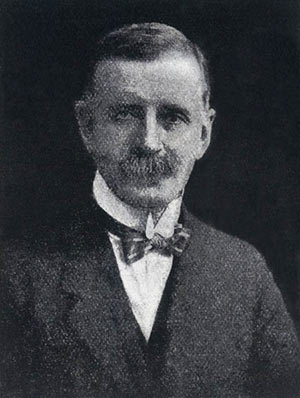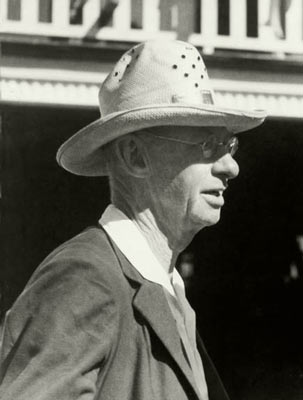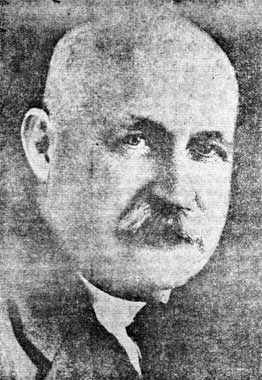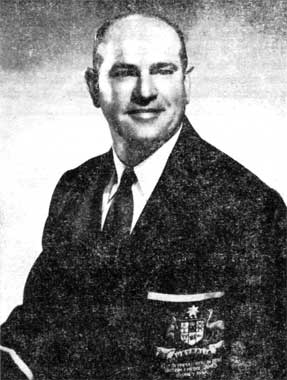
Sydney Rows
A Centennial History of the Sydney Rowing Club, 1970, by A L May
Table of Contents
Chapters
- Preliminaries: before 1870
- Foundations: 1870-1880
- New Clubs: 1880-1890
- The Amateur Question: 1890-1900
- Sydney on Top: 1900-1910
- Henley and War: 1910-1920
- Pearce and Mosman: 1920-1930
- Financial Problems: 1930-1940
- War and Wood: 1940-1950
- Strength and Stability: 1950-1960
- On Top Again: 1960-1970
Appendices
8. Financial Problems: 1930-1940
Sydney was the first club back into the premiership position when Mosman's long run ended in 1932/33. The premiership was won again in 1933/34, but the club had to be content with second place in the two succeeding years. Thereafter, success on the river proved much harder to come by and enthusiasm dwindled considerably. Meanwhile, too, financial problems were continuing to cause considerable concern.
The club's buildings caused the committee little worry until 25 August, 1934 when fire broke out at the Branch. A large portion of the club house premises was destroyed, including the lounge and the dining and billiard rooms and their contents (which included many old trophies won by members). Substantial repairs and alterations were required.
Early in 1937, a severe storm also tore off portion of the roof of the rowing shed at the Branch. Despite serious financial difficulties, the committee then prepared plans to spend almost £1,000 on the erection of a new building at the Branch. In the event, no construction took place. A minor accomplishment was the connection of the Branch premises to the sewer in 1938/39.
Although the Woolloomooloo premises did not require any major repairs, there were still other problems. By about the middle of the decade, the Branch had become the centre of the club's activities and there was little interest in the Domain shed. Most of the fleet was transferred to Abbotsford and the boats at the 'loo and the shed itself fell into poor condition. Considerable thought was give to dispensing with the services of Pearce, the long-time caretaker, and he was finally dismissed just as war broke out. The sale of the Domain shed was being seriously considered at the end of the decade.
A number of additions to the fleet took place in the 'thirties but more craft still were disposed of or were reduced to being "out of commission". The effective fleet of 22 in 1930 had fallen to only 15 in 1937/38. The 15 comprised a racing eight, two practice eights, a racing four, five regulation fours, a clinker four, three pair oars and two gladstone skiffs. In addition, two practice eights and a best and best four were out of commission. The number of gladstone skiffs had been seven in 1930/31, but fell to five in 1931/32 and to two in 1933/34.

C A Smith
A new Towns eight, the C. A. Smith, was purchased in 1932, financed largely from donations, while H. R. Dixon presented a new regulation four about the same time which was subsequently named after him. In 1936/37, two more regulation fours were donated, the Phyl. and Ruth Simpson and the A. S. Burdekin. In 1937/38, George Steen made a substantial donation to make possible the purchase of a new eight bearing his name.
Much of the financial problems lay in the membership position. The number of members failed to regain the 1928 level of 305 during the whole of the 1930's. In 1933/34, in fact, the figure fell to as low as 173. It built up again to 242 in 1937/38 but was back to 198 a year later (after a number of members had been written off for non-payment of fees due). Life membership remained at around 50, but associate membership was rarely over 100 and fell to 60 in 1933/34 and to 63 again in 1938/39. Subscriptions were, of course, much affected by these figures. From a level of £728 in 1928/29 they were down to around £320 in the early years of the new decade.
Problems at the Branch added to the difficulties. In 1930/31, only two members were in residence, and the committee appealed for more patronage to place the Branch on a paying basis. Branch losses ran at over £100 a year in the early years of the decade while, in 1933/34, the Woolloomooloo shed account showed an excess of expenditure over income of £151. It became impossible, despite donations, to pay the interest on the ₤850 mortgage and the ₤200 debentures still outstanding. The amount outstanding to sundry creditors, including George Towns and Drummoyne Council, grew to over ₤500.

Ernie Keary
In August, 1934, when the fire took place, three members were resident at the Branch: Ernie Keary, "Minty" Wadsworth and Max Napier. Many others, of course, made use of the club's accommodation on an occasional basis.
Even before the fire, drastic solutions were being considered. The 1933/34 committee appointed a special Finance Committee to review the situation. It placed the details of the club's finances before the Trustees and sought amelioration of the situation but without success. The committee then proposed a drastic way out of the problem: sell the Branch. The 1934 annual meeting discussed the position at length and appointed a sub-committee to examine the matter and devise a scheme to meet the club's commitments without resorting to such a major step.
A special general meeting in September, 1934, decided that economies should be effected at the Branch and a membership drive inaugurated. The fire added to the difficulties, necessitating repairs and replacements and seriously curtailing possible activities. The insurance money was utilized, however, to reduce the mortgage by ₤425 (exactly half).
In 1935, both Sir Samuel Hordern and Dame Eadith Walker donated their £50 debentures to the club. Shortage of permanent boarders was still hindering Branch operations in 1936/37, in which year a loss of £125 on the Branch account was realised. There were now proposals to ease the position by selling the Woolloomooloo shed, by selling more land at the Branch, and by selling the Branch's liquor license.
It was also now, rather strangely, that borrowing from the A.M.P. to erect a new building at the Branch was mooted. The amount suggested was £1,500 to enable repayment of the mortgage and of the outstanding rates as well. In April, 1937, a special general meeting decided not to give approval until a full financial statement and full plans were before it, as it was feared the club might not be able to meet the added expenditure.
Consideration was also given to asking members to pay the whole of their race entry fees (at 2/6 a man) instead of the existing half, while members in arrears were followed up closely. Committee members subscribed to lottery tickets in the name of the club, a number of small prizes being won, and it was only the legal uncertainty which discouraged the club from installing a "fruit machine" in 1937.
Considerable changes in the management of the Branch were made in 1937/38. Permanent boarding was terminated, although the Branch continued to cater to crews in training and to provide casual meals. Liquor prices were also increased. A small surplus was shown in operations and, coupled with economies in the shed management and higher income from subscriptions, the financial position became easier. In March, 1939, assets were valued at ₤4,874, the major items being club house and land at Abbotsford ₤2,956; club house, Domain ₤906; fleet ₤640; and boat shed and pontoon at Branch ₤125. Liabilities were ₤787, comprising the mortgage £425, debentures plus interest, £115, a Rural Bank loan of ₤65 and sundry creditors totalling £182.
A new president was elected in the decade. After six years in the position, Clarrie Smith resigned in 1934/35 upon going abroad. During his period of office, he had been indefatigable in his efforts on behalf of the club. "During the troublous years of the depression Mr. Smith was always ready to assist the club in every way, and was mainly instrumental in helping it over the most difficult period in its history".

A W Snedden
The choice of a successor fell on Andrew Sneddon, who had first joined the club in 1902. Sneddon was a well known figure in the commercial world, being general manager and actuary of the A.M.P. Society. The vice-presidents' list under went numerous changes in the period and, at the end of the decade, there were 18 names on the list. They were O. H. Baass, E. R. Barker, H. K. W. Corden, J. H. Fairfax, A. W. Cains, A. C. Ebsworth, R. B. Fitzhardinge, E. E. Keary, Sir Samuel Hordern, Sir Archibald Howie, F. T. D. Meares, C. H. Kloster, W. J. Middleton, C. M. Moesch, T. P. Mulholland, H. F. Pike, Col. R. L. R. Rabett and C. A. Smith. Vice-regal patronage continued throughout the 'thirties.
The club was fortunate in having an experienced captain during the depression years. Tom Mulholland accepted the post in 1930/31 and held it for seven years. "Mull", a member of Shannon Rowing Club in Ireland before migrating to Australia, had joined Sydney in 1912 and had previously been captain from 1922/23 to 1924/25.
Captains in the last three years of the decade were Cliff Lambert, Bill Dixon and Cliff Ebsworth respectively. Bert Goulding and Peter Groom were vice-captain for three years each in this period and Jock Boulton for two years.
The task of secretary was taken on for two years each by Reg O'Carroll, Norm Lawrance, Norm Castle, Eric Perry and Dick Crebbin. Geoff May was treasurer for three of the difficult years, with Bill Callaway and Cliff Ebsworth also holding this position for two years each. Prominent amongst long-serving committee members in the 'thirties were Charlie Saleh, Frank Lester, Claude Rosevear, Tom Nickson and Fred Pike.
The number of committee members was increased from nine to eleven in 1935 but the 1940 annual meeting cut the number down to six. The position of honorary providore was replaced by an honorary Branch manager in 1930/31 and, later still, by a house or Branch committee. The 1940 meeting, however, reinstituted the position of Branch manager. In 1937/38, Mrs. Hyland, housekeeper at the Branch for many years, retired through ill-health and was succeeded by a married couple.
At the annual meeting in 1935, the idea of an annual order of merit blazer was put forward. While approved in principle, the meeting asked for clarification at the following year's meeting. Accordingly, in 1936, the club captain, Tom Mulholland, author of the scheme, introduced and the meeting unanimously approved the following motion:
"An Order of Merit Award shall be made each year to that member who shall have rendered the most outstanding services to the club during his membership, his name to be inscribed on an Honour Roll erected for that purpose. One member only shall be elected each year by the Committee, and shall be recommended to the General Meeting. The Award shall take the form of a pale blue blazer, with gold club monogram pocket, and gold buttons, the cost of which shall be defrayed from donations by Club members."
Frank Leister was then nominated and approved as the first recipient of the Honour Blazer. For 1936/37, the award was made to Bert Goulding, in 1937/38 to Tom Mulholland, in 1938/39 to Norm Lawrance and in 1939/40 to Cliff Lambert. Two "honorary life members" were also created in the period, the first such honours in the club's history. The first was Bob Pearce in the early part of the decade and, in 1937, Bill Dixon was similarly honoured.

Bill Dixon
As in previous years, death took many very fine members from the club's ranks. They included Edward Simpson, Charles Dobson, William Hanna, Edward Lamont, Arthur Shadforth, John Thomson, William Cope, Ted Kennedy, Claude Rosevear, Bill Goulding, Arthur Burdekin, Dame Eadith Walker, Ted Pearson, Nick Johnson and Judge Grantley Fitzhardinge.
One or two new members at the end of the decade deserve a special note. The membership of Harry Clare was accepted from 1 December, 1938 "subject to references". In November, 1939, he was elected to fill a vacancy on the committee but he resigned two months later on enlisting. In July, 1939, the application of G. E. Parlby, newly-arrived from England and a former Thames Rowing Club oarsman, was accepted and, a month later, it was announced that he would act as shed supervisor at the 'loo during the summer months and undertake the conducting of the summer point score.
Social activities were a regular part of the club's life in the decade. Annual balls continued, with good attendances being realised and the club's funds also benefiting. There were 462 present at David Jones' ballroom in 1930, while a peak profit of over ₤60 resulted from the 1937 function.
Smaller dances were also held frequently at the Branch - in 1936 the permanent boarders were urging limiting them to one every three weeks - with minor incidents occurring from time to time. One or two launch picnics were also arranged. The Ladies' Sub-Committee proved very valuable on the social front once again. Mrs. C. A. Smith headed the group for a time, with Miss Maud Honey, subsequently Mrs. Jack Goulding, proving a hard-working secretary and later president. In 1934/35, a Younger Set Committee, a "rival" group in many ways, was also formed. Known as the "Undesirables" for a time, this group organised informal dinner dances after each regatta and other entertainment as well as co-operating with the Ladies' Sub-Committee in major functions. It proved very successful in fund raising and, in 1936, was able to present a regulation four to the club from its proceeds. In 1938, the Ladies' Sub-Committee and the Younger Set amalgamated and social functions were organised thereafter by the one body.
The winter point score was also a well established club feature. In the early years of the decade, only two divisions, "A" Grade for the Deloitte Cup and "B" Grade for the "Jacobs Cup" were held, but a third "novice" grade was reintroduced in 1933/34 with Claude Rosevear presenting a handsome trophy for this division. Trophies for coxswains were also awarded. Winners of the major trophy during the decade included Harry Solomon, Geoff Bates, Jack Langley (twice), Wally Symons, Reg O'Carroll, Norm Grounds, Jock Boulton, Eric Perry and Doug Bain. The Deloitte Cup itself was lost in the fire of 1934, but a replacement was presented. By 1936/37, the Jacobs Cup had also been replaced by the "Kerr Cup".
In the 1934/35 season, a summer pointscore was inaugurated to maintain activity at the Domain shed and to hold the interest of new members and members not training for competition regattas. George Steen and Ted Downie presented cups for the competition which was rowed in fours for the more advanced oarsmen and pairs for the novices. A series of eleven races was held from October 1934 to April 1935 with J. Henderson winning the Steen Cup for fours and J. Smail the Downie Cup. The competition continued, with considerable interest being shown, throughout the remainder of the decade. Other winners of the Steen Cup included Evan Sawkins, Reg Gamble and Tom Crawford. In 1930/ 31, the "R. M. Stephen Cup" was presented to the club for award by the committee each year. Presented for the most improved oarsman, it was given five times only, the winners being Geoff May, Bill Dixon, George Wood, Norm Pottie and Norm Simpson.
The club had some outstanding coaches in the decade. Claude Rosevear (heavyweights) and Charlie Saleh (lightweights) were the top coaches in the early years of the period, with able assistance coming from George Hancock, Max Napier, Bert Goulding and a number of others. The former two also bore the brunt of the selecting work.
Ernie Keary returned to the club in 1932/33 to take over the senior coaching when Rosevear stepped down for health reasons (transferring later on to Nepean). Keary had, of course, outstanding success. Saleh and Napier also continued to gain many wins with their crews, while Norm Pottie and Cliff Lambert joined the ranks of successful coaches.
At about the same time, a system of selection committees, usually one for seniors and one for juniors, was adopted by the club. By 1936/37, Staunton Hoskins had taken over the lightweight coaching with Norm Pottie and Bert Goulding taking some of the burden of the senior coaching from the shoulders of an ailing Ernie Keary. Dick Crebbin and Ossie Rosevear were working hard with the maiden and junior crews, while Norm Lawrance, Harry Gilmour, Frank Lester and Norm Grounds were among the other members assisting in coaching work in the second part of the decade.
